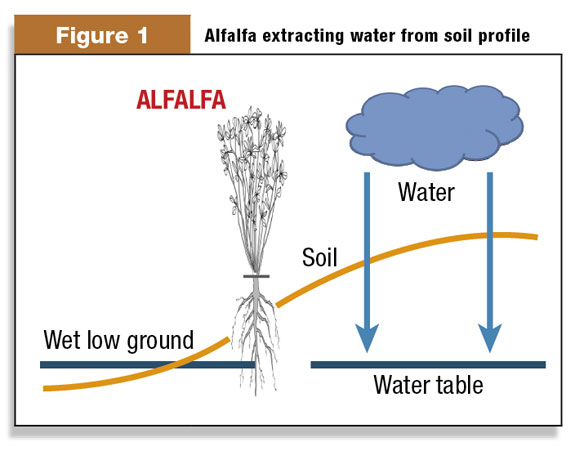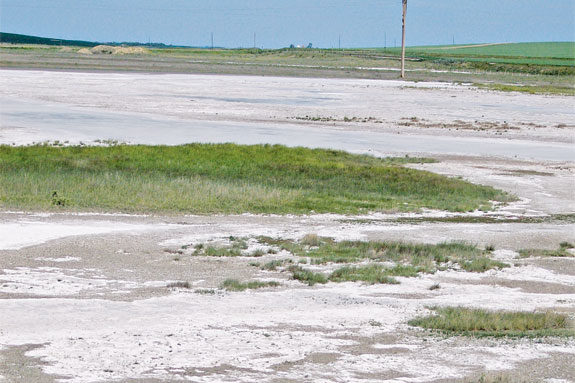Both these extremes resulted in increased farm expenses as well as lost revenue.
Weather-related problems are nothing new to farmers, and they often struggle with the question of what cropping strategies they should use to help buffer the effect of these extremes in weather and still make a profit.
Alfalfa producers have known for years that alfalfa has several cropping advantages under drought conditions, due mainly to its deep taproot that can access soil moisture to a greater depth than most crops.
However, researchers are currently suggesting that the same rooting characteristic also makes alfalfa a crop farmers should seriously consider including in their crop plan to help minimize losses not only in drought situations but also during prolonged wet periods.
Drought advantage
In periods of drought, alfalfa producers have always taken some solace in the fact that although alfalfa is generally considered a high water user, it is relatively drought-tolerant and can survive extended periods with minimal stand loss.
This drought tolerance stems from alfalfa’s extensive root system that can reach soil depths of 5 to 6 feet in the first year of growth and depths of 25 feet or more in mature stands.
This strong, deep taproot system allows alfalfa to extract soil moisture at greater depths, enabling it to survive and maintain growth longer than most crops.
The root system also provides a buffering effect to forage production losses during low water periods and can minimize or eliminate stand losses that can result in the added expense of replanting damaged or lost stands due to drought.
Alfalfa’s advantage in reclaiming wet soils
The problem of excessive soil moisture and rising water tables has recently come to the forefront in states like North Dakota, which has seen back-to-back abnormally wet years and with extended wet periods that have adversely affected farming operations.
During these wet periods, excess moisture not utilized by shallow-rooted plants or from fallow ground percolation penetrates through the soil profile and significantly contributes to a rise in water table levels.
In many regions the water tables have risen to such a level that they have discharged into low-lying fields, making them unfarmable due to wet, soggy soil conditions.
In some cases, the soil water that has reached the surface has brought with it dissolved salts, which eventually accumulates on the soil surface and severely limits crop production.
As a means of trying to reclaim these fields, researchers have proposed alfalfa as one crop option that could be utilized in a long-term integrated approach to solving the excessive moisture problem.
Research has shown that alfalfa’s deep taproot can be very effective in removing significant amounts of unwanted excess moisture from soil profiles.
Alfalfa’s utilization of shallow and deep soil moisture, coupled with its high water usage (48 to 60 inches per year), makes it an excellent crop choice in helping to deplete excess soil moisture from water table recharge zones.
This drying effect on the soil profile can, in turn, reduce the flow of excess soil water into the water table that eventually leads to the flooding and loss of production on low-lying farm ground.
Utilizing alfalfa to reclaim farm ground
Solutions to weather-related problems are never easy, but in order to effectively deal with the problem of rising water tables, farmers need to develop a long-term strategy.
This plan should combine sound agronomy techniques combined with a good cropping strategy to effectively minimize the effect of prolonged wet conditions. The following points are a few suggestions on how alfalfa may best fit into that strategy.
1. Determine which regions of your farm are water table recharge zones.
Strategically planting alfalfa in water table recharge zones can contribute significantly to lowering actual water table levels across the farm and returning low-lying fields to production.
To achieve maximum effect, producers should establish alfalfa fields on as many of those recharge regions as possible (two to three times the size of the water-saturated areas).
Research has shown that if the newly planted alfalfa acreage is adequate, the water levels can significantly reduce the first year or two and continue to drop for several years and then begin to taper off after five years.
Therefore, long-term alfalfa rotations are preferred and should be considered in order to achieve maximum effect and long-term water control.
Fallowing ground should be avoided if at all possible, since the absence of plants will result in more water percolation into the water table.
2. Utilize new salt-tolerant alfalfa varieties for optimal stand establishment in saline-affected areas.
Improved salt-tolerant cultivars are now available for regions experiencing saline problems associated with rising water tables.
The very first listing of certified salt-tolerant alfalfa varieties was published in late 2011 and can be found on the National Alfalfa & Forage Alliance website at http://www.alfalfa.org
3. Dormant (frost) seed wet saturated ground in the late fall or winter when it is frozen.
The difficulty of planting in wet, muddy soils is overcome by planting at a time of the year when soils are more stable due to freezing temperatures, and the seed will remain dormant during the winter months and then be in place for germination after the spring thaw.

Any success in establishing plants in these regions using this method will contribute to the reduction of excess soil moisture.
Summary
Recent research has shown that alfalfa’s deep taproot not only helps it survive in times of drought, but can also be very effective in removing significant amounts of unwanted excess moisture from soil profiles (Figure 1) that is the result of flooding and/or rising water tables due to extended wet periods.
Alfalfa’s utilization of shallow and deep soil moisture, coupled with its high annual water usage, makes it an excellent crop choice as a tool in a long-term integrated approach to reducing excess soil moisture from soil profiles that eventually contribute to the loss of production in low-lying fields. FG
PHOTO:
Photo: Salt accumulation on low-lying wet fields can be reclaimed with saline tolerant alfalfa. Photo courtesy of the Grainger-Allen family.











